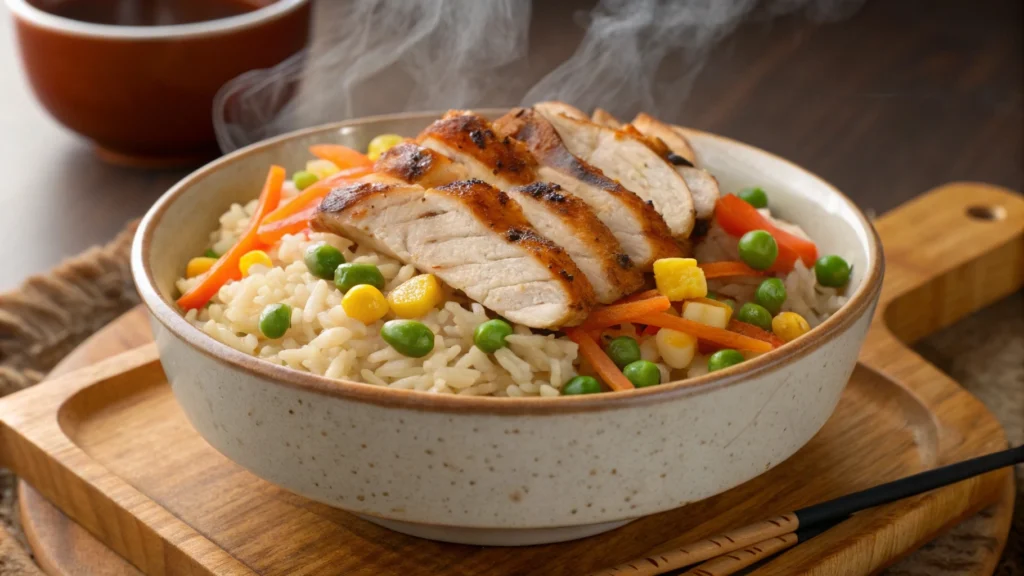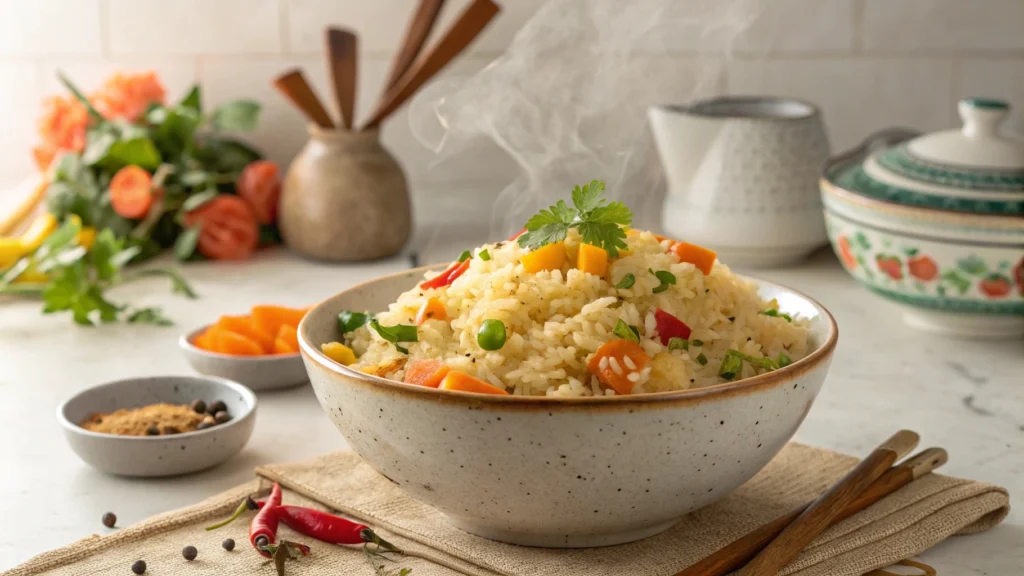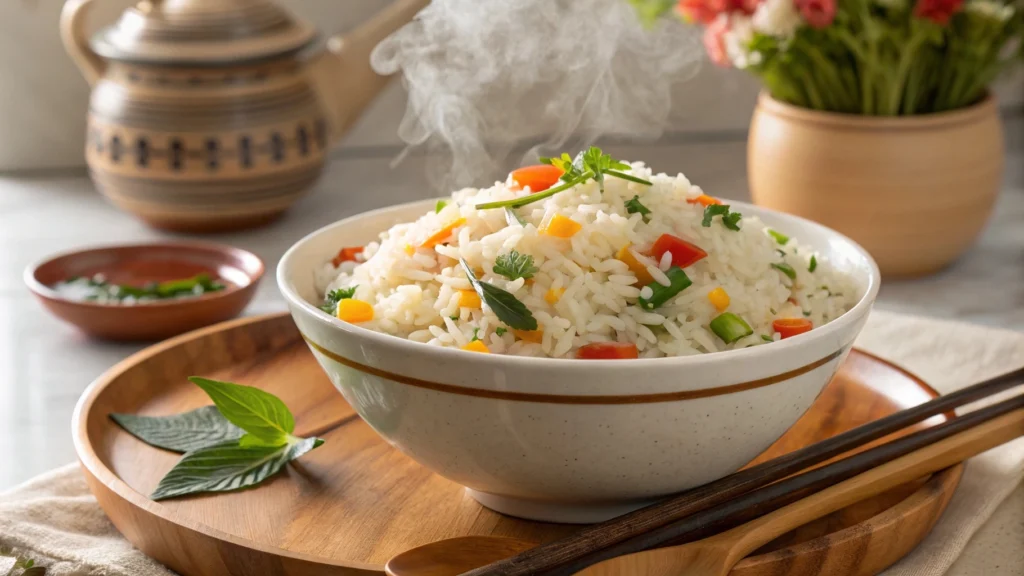
Have you ever stood in the grocery store aisle, facing a daunting array of Rice recipes varieties, feeling a tad overwhelmed? Or perhaps you’ve attempted to cook that “perfect” pot of rice, only to end up with a sticky, clumpy mess? Don’t worry, you’re not alone. Rice, a seemingly simple grain, holds a universe of culinary possibilities and a rich history that spans cultures and continents. This isn’t just another article about rice; it’s your personal passport to understanding, cooking, and savoring every single grain, from its humble beginnings in the paddy fields to the delightful dishes you can create in your very own kitchen. Get ready to embark on a flavorful journey that will transform the way you think about and cook with rice.
Unveiling the Diverse World of Rice Varieties: Finding the Perfect Grain for Your Needs
Just like there’s a perfect shade of blue for every sky, there’s a perfect type of rice for every culinary creation. Understanding the nuances between different varieties can elevate your cooking from ordinary to extraordinary. Let’s explore the fascinating spectrum:
Long-Grain Champions: Basmati and Jasmine
- Key Points: Long grains are known for their slender shape and the way they remain separate and fluffy after cooking.
- Basmati: Originating from the foothills of the Himalayas (India), Basmati boasts a distinct nutty aroma and a delicate, elongated grain. It’s your go-to for biryanis, pilafs, and any dish where you desire individual, non-sticky grains.
- Data/Sources: Reference the geographical origin and traditional uses in Indian and Persian cuisines.
- Jasmine: Hailing from Thailand, Jasmine rice exudes a fragrant, floral aroma reminiscent of jasmine blossoms. Its slightly stickier texture makes it ideal for Southeast Asian dishes like stir-fries and curries, where it beautifully absorbs sauces.
- Data/Sources: Mention its Thai origin and its importance in Thai, Cambodian, and Vietnamese cooking.
The Middle Ground: Medium-Grain Marvels
- Key Points: Medium-grain rice is shorter and plumper than long-grain, with a slightly higher starch content, resulting in a tender and somewhat sticky texture.
- Arborio: The star of Italian risotto, Arborio rice has a high amylopectin (starch) content, which it slowly releases during cooking, creating that signature creamy texture while maintaining a slightly firm center (“al dente”).
- Data/Sources: Detail the risotto-making process and the importance of the gradual starch release.
- Sushi Rice: Also a medium-grain variety, sushi rice has a sticky consistency that allows it to clump together perfectly for sushi rolls and nigiri. It’s often seasoned with rice vinegar, adding a distinctive tang.
- Data/Sources: Explain the preparation process involving washing and the addition of vinegar.
Short-Grain Wonders: For Cling and Creaminess
- Key Points: Short-grain rice is almost round and has the highest starch content, resulting in a very sticky texture when cooked.
- Glutinous Rice (Sticky Rice): Despite its name, it doesn’t contain gluten. This type of rice becomes exceptionally sticky when steamed and is a staple in many Asian desserts and savory dishes.
- Data/Sources: Highlight its uses in Southeast Asian desserts and Laotian cuisine.
- Pudding Rice: Certain short-grain varieties are specifically suited for creamy desserts like rice pudding due to their high starch release.

Exploring the Nutritional Powerhouses: Whole Grain and Specialty Rices
- Key Points: These rices offer unique flavors, textures, and enhanced nutritional profiles.
- Brown Rice: A whole grain, meaning it retains the bran and germ layers, making it richer in fiber, vitamins, and minerals compared to white rice. It has a nuttier flavor and a chewier texture.
- Data/Sources: Cite nutritional comparisons between brown and white rice from reputable sources.
- Wild Rice: Technically a grass seed, wild rice offers a chewy texture and an earthy, nutty flavor. It’s often mixed with other rices in pilafs and salads.
- Data/Sources: Mention its North American origin and nutritional benefits.
- Black Rice (Forbidden Rice): This striking dark-colored rice is rich in antioxidants and has a slightly sweet, nutty flavor.
- Data/Sources: Highlight its antioxidant properties and traditional association with royalty in ancient China.
- Red Rice: With its reddish-brown hue, red rice gets its color from anthocyanins, the same antioxidants found in berries. It has a nutty flavor and a slightly chewy texture.
- Data/Sources: Discuss its antioxidant content and potential health benefits.
Mastering the Art of Cooking Perfect Rice: Your Step-by-Step Guide to Fluffy Success
Say goodbye to mushy or undercooked rice! Achieving perfectly cooked rice is simpler than you might think. Let’s explore the fundamental techniques:
The Stovetop Method: A Classic Approach
- Rinsing is Key: Before cooking, rinse your rice under cold water until the water runs clear. This removes excess starch, which contributes to stickiness.
- The Water-to-Rice Ratio: This is crucial and varies slightly depending on the type of rice. A general guideline is a 1:2 ratio of rice to water for white rice. Brown rice typically requires more water (around 1:2.5). Always check the package instructions for specific recommendations.
- Bringing to a Boil: In a pot with a tight-fitting lid, combine the rinsed rice and the correct amount of cold water. Bring it to a rolling boil over medium-high heat.
- Simmering is Essential: Once boiling, reduce the heat to the lowest setting, cover the pot tightly, and simmer for the recommended time (usually 15-20 minutes for white rice, 40-50 minutes for brown rice). Do not lift the lid during simmering, as this releases steam and affects the cooking process.
- Resting for Fluffiness: After simmering, remove the pot from the heat and let it stand, covered, for 5-10 minutes. This allows the steam to redistribute and the grains to fully absorb the remaining moisture, resulting in fluffy rice.
- Fluffing with a Fork: Finally, gently fluff the rice with a fork to separate the grains before serving.
The Convenience of Electric Rice Cookers
- Key Points: Rice cookers take the guesswork out of cooking rice, consistently producing perfectly cooked grains with minimal effort.
- How They Work: Simply add the rinsed rice and the correct amount of water to the inner pot, close the lid, and press the “cook” button. The cooker automatically detects when the rice is cooked and switches to a “keep warm” setting.
- Tips for Success: Follow the water-to-rice ratios specified in your rice cooker’s manual. Some models have settings for different types of rice.
Pressure Cooking for Speed and Efficiency
- Key Points: Pressure cookers significantly reduce the cooking time for rice, making them ideal for busy individuals.
- General Guidelines: Follow your pressure cooker’s instructions for specific rice types and water ratios. Typically, white rice cooks in just a few minutes under high pressure, followed by a natural or quick release of pressure.

Elevating Flavor: Infusions and Enhancements
- Cooking with Broth: Instead of water, try cooking your rice in chicken, vegetable, or beef broth for added depth of flavor.
- Aromatics and Spices: Add whole spices like bay leaves, cardamom pods, or cinnamon sticks to the cooking water for a subtle aromatic infusion. You can also sauté aromatics like onions and garlic in a little oil before adding the rice and liquid.
- Herbs and Zest: Stir in fresh herbs like parsley, cilantro, or thyme, or a bit of lemon or lime zest, after the rice is cooked for a bright, fresh finish.
- Butter or Oil: A small pat of butter or a drizzle of olive oil after cooking can add richness and prevent the grains from sticking.
Troubleshooting Common Rice Cooking Woes
- Sticky Rice: Usually caused by too much water or not rinsing the rice adequately. Try using less water next time and ensure thorough rinsing.
- Burnt Bottom: Reduce the heat to the lowest possible setting during simmering and use a heavy-bottomed pot to distribute heat evenly.
- Undercooked Rice: This can happen if not enough water was used or if the simmering time was too short. Add a little more water and continue simmering, covered, until the rice is tender.
Rice and Your Health: Unpacking the Nutritional Benefits and Considerations
Rice isn’t just a staple; it’s a source of energy and essential nutrients. Let’s delve into its nutritional profile:
The Macronutrient Breakdown
- Carbohydrates: Rice is primarily composed of carbohydrates, providing the body with its main source of energy. The type of carbohydrate and its impact on blood sugar levels vary depending on the type of rice.
- Data/Sources: Provide general carbohydrate content per serving for different rice types.
- Protein: Rice contains a moderate amount of protein, though it’s not considered a complete protein as it lacks sufficient amounts of all essential amino acids.
- Data/Sources: Offer protein content comparisons.
- Fiber: Brown rice is significantly higher in fiber than white rice due to the presence of the bran layer. Fiber aids in digestion, helps regulate blood sugar levels, and promotes feelings of fullness.
- Data/Sources: Quantify the fiber difference between brown and white rice.
Understanding the Glycemic Index (GI)
- Key Points: The GI measures how quickly a food raises blood sugar levels. White rice generally has a higher GI than brown rice.
- Data/Sources: Provide GI ranges for different types of rice and explain the implications for blood sugar control.
- Factors Affecting GI: Cooking methods and portion sizes can also influence the GI of rice.
Micronutrients and Antioxidant Power
- Vitamins and Minerals: Brown rice is a good source of manganese, selenium, phosphorus, magnesium, and B vitamins. White rice loses some of these nutrients during processing.
- Data/Sources: List key vitamins and minerals present in brown rice and note the reduction in white rice.
- Antioxidants: Black and red rice are particularly rich in antioxidants, which help protect the body against cell damage.
- Data/Sources: Highlight the specific antioxidants found in black and red rice, such as anthocyanins.
- Rice Bran: The outer layer of the rice grain, rice bran, is a good source of fiber and certain vitamins and minerals. It’s available as a separate product.
Rice in Gluten-Free and Other Dietary Contexts
- Naturally Gluten-Free: All types of natural rice are inherently gluten-free, making them a safe and versatile grain for individuals with celiac disease or gluten sensitivity.
- Rice Flour: Ground rice is used to make rice flour, a gluten-free alternative to wheat flour in baking and thickening sauces.
- Considerations for Specific Diets: Depending on dietary restrictions (e.g., low-carb, ketogenic), portion control and the type of rice consumed are important factors to consider. Brown rice, with its higher fiber content, is often preferred over white rice in balanced diets.
From Paddy to Plate: Tracing the Journey and Ensuring Proper Storage
Understanding where your rice comes from and how to store it properly can enhance your appreciation and ensure its quality.
A Glimpse into Rice Cultivation
- Paddy Fields: The iconic image of rice cultivation involves flooded fields called paddies, which help control weeds and provide the necessary water for rice growth.
- The Growing Process: Rice plants go through various stages, from planting seedlings to the development of grains and finally harvesting.
- Global Regions: Rice is a staple crop in many parts of the world, particularly in Asia. Different regions have unique cultivation practices and dominant rice varieties.
The Transformation: From Grain to Shelf
- Milling: After harvesting, rice undergoes milling to remove the inedible outer husk. Brown rice retains the bran and germ layers, while white rice has these layers removed.
- Polishing: White rice is often further polished, which removes additional nutrients and gives it a smoother, whiter appearance.
- Packaging and Distribution: The processed rice is then packaged and distributed to stores worldwide.
The Art of Rice Storage: Maintaining Freshness
- Uncooked Rice: Store uncooked rice in an airtight container in a cool, dry place away from direct sunlight and strong odors. Properly stored white rice can last for several years, while brown rice has a shorter shelf life (around 6 months) due to its natural oils.
- Cooked Rice: Leftover cooked rice should be cooled quickly and stored in an airtight container in the refrigerator for no more than 3-4 days. Ensure it’s reheated thoroughly before consumption.
The Global Significance of Rice
- A Staple Food: Rice is a primary food source for billions of people worldwide, particularly in Asia.
- Cultural Importance: Rice plays a significant role in the cultural traditions, ceremonies, and cuisines of many societies.
- Economic Impact: The cultivation and trade of rice are vital to the economies of numerous countries.

Culinary Adventures with Rice: Inspiring Recipes and Uses to Delight Your Palate
Now for the exciting part: transforming those grains into delicious meals! Here are some inspiring ideas:
Rice Classics: A Taste of the World
- Italian Risotto: A creamy and comforting dish made by slowly cooking Arborio rice in broth, often with butter, cheese, and other flavorful ingredients. | Ingredient | Quantity || :————– | :——— || Arborio Rice | 1.5 cups || Chicken Broth | 6 cups || Onion (chopped) | 1 medium || Dry White Wine | 0.5 cup || Parmesan Cheese | 0.5 cup || Butter | 4 tbsp || Olive Oil | 2 tbsp || Salt and Pepper | To taste |
- Spanish Paella: A vibrant and flavorful rice dish typically containing seafood, meat, vegetables, and saffron.
- Data/Sources: Include a basic paella recipe with key ingredients like saffron and seafood.
- Indian Biryani: A fragrant mixed rice dish with spices, meat (chicken, lamb, or beef), vegetables, and yogurt.
- Data/Sources: Provide a simple chicken biryani recipe.
Versatile Ways to Use Cooked Rice
- Stir-Fries: Add cooked rice to your favorite stir-fry with vegetables, protein, and a flavorful sauce.
- Salads: Cold cooked rice can be a base for refreshing salads with vegetables, herbs, and a light dressing.
- Soups: Incorporate cooked rice into hearty soups for added texture and substance.
- Rice Pudding: A classic dessert made by simmering rice with milk, sugar, and flavorings like vanilla or cinnamon.
Beyond the Grain: Creative Rice Applications
- Rice Flour Baking: Explore gluten-free baking with rice flour in cakes, cookies, and pancakes.
- Rice Water for Beauty: In some cultures, rice water (the starchy water left after rinsing or cooking rice) is used as a hair rinse or facial toner.
Quick and Easy Rice Recipes for Busy Lives
- One-Pot Lemon Herb Rice: Cook rice with chicken broth, lemon juice, and fresh herbs for a simple and flavorful side dish.
- Quick Fried Rice: Use leftover cooked rice to whip up a speedy fried rice with vegetables and eggs.
Frequently Asked Questions About Rice Recipes
What is the best way to cook fluffy rice recipes?
For consistently fluffy rice recipes, remember to rinse your rice before cooking, use the correct water-to-rice ratio (usually 1:2 for white rice), bring it to a boil, then simmer covered on low heat without lifting the lid, and let it rest for 5-10 minutes before fluffing with a fork.
Are brown rice recipes healthier than white rice recipes?
Generally, brown rice recipes offer more fiber, vitamins, and minerals compared to white rice recipes because brown rice retains the bran and germ layers.
Can I use any type of rice for all rice recipes?
While you can technically use any type of rice, the texture and flavor will vary significantly. Certain rice varieties are better suited for specific rice recipes (e.g., Arborio for risotto, Jasmine for Thai curries).
How should I store leftover rice recipes?
Cool leftover rice recipes quickly and store them in an airtight container in the refrigerator for no more than 3-4 days. Reheat thoroughly before serving.
Where can I find more delicious rice recipes?
You can find a plethora of inspiring rice recipes online, in cookbooks, and through culinary blogs and websites. Explore different cuisines and experiment with various types of rice and flavor combinations.
Conclusion: Embrace the Versatility and Delight of Rice
From the simplest side dish to the most elaborate culinary creation, rice is a grain that nourishes bodies and connects cultures. By understanding the different varieties, mastering the cooking techniques, and exploring the endless possibilities of rice recipes, you’ve unlocked a world of flavor right in your kitchen. So go ahead, experiment, savor, and enjoy the journey from grain to plate.
Call to Action: What’s your favorite way to cook rice? Share your go-to rice recipes and tips in the comments below! We’d love to hear about your culinary adventures with this versatile grain.
